Oh I almost forgot!!! Please be careful and know which way the wheels are rotating!! I had an accident and it could have been a lot worse... totally my fault. I had the wheels rotating away from me and I went to sharpen like the manufacture says with the edge down on the front of the wheel and BAMMMM!!! the knife popped up and hit me in the face right next to my eye and took a chunk out of my arm. I had 2 stitches by my eye and 7 in my wrist. Of course my safety glasses were on top of My head... but yeah please be careful everyone and never get complacent!!
You are using an out of date browser. It may not display this or other websites correctly.
You should upgrade or use an alternative browser.
You should upgrade or use an alternative browser.
paper sharpening wheels - when your time is important to you
- Thread starter richard j
- Start date
Been using them for a few months. I don't have the gritted wheel just the polisher. I read this thread last night which gave me a few great tips. Thanks fellas. The big one was if you need to strop afterwards your doing something wrong. So I had at it today. Sharpened a few kitchen and pocket knives. Ridiculously sharp! I cut the primary with 220 grit belt. Boom! Right to paper wheel and wow! Anyway just wanted to say thanks.
Update on the Takamura R2 210 Gyuto from post #1816:
According to the Chef this edge done on Paper Wheels lasted him 2 months in his commercial kitchen, which was just as long as the factory edge had lasted him.
During that time he sometimes touched up the edge by stropping it on an MDF strop with 1.0 micron diamond compound until that no longer worked satisfactory (in the last week or so), after which he used a fine ceramic rod on it.
Differences with the factory edge were that the Paper Wheel edge had a slightly smaller edge angle (+/- 20 degrees inclusive instead of +/- 22,5 degrees inclusive), was finer polished, and had a higher sharpness.
We're still in the process of finetuning the edge to his specific requirements, and next time he brings in the knife it will probably get a little less refined edge to see if it's useful life can be prolonged a bit more.
In his kitchen the real edge killers are the mandatory plastic cutting boards which are very abrasive on knife edges, together with the almost unavoidable tiny sand particles which sometimes remain in the huge quantities of vegetables that need to be processed.
According to the Chef this edge done on Paper Wheels lasted him 2 months in his commercial kitchen, which was just as long as the factory edge had lasted him.
During that time he sometimes touched up the edge by stropping it on an MDF strop with 1.0 micron diamond compound until that no longer worked satisfactory (in the last week or so), after which he used a fine ceramic rod on it.
Differences with the factory edge were that the Paper Wheel edge had a slightly smaller edge angle (+/- 20 degrees inclusive instead of +/- 22,5 degrees inclusive), was finer polished, and had a higher sharpness.
We're still in the process of finetuning the edge to his specific requirements, and next time he brings in the knife it will probably get a little less refined edge to see if it's useful life can be prolonged a bit more.
In his kitchen the real edge killers are the mandatory plastic cutting boards which are very abrasive on knife edges, together with the almost unavoidable tiny sand particles which sometimes remain in the huge quantities of vegetables that need to be processed.
russde
Gold Member
- Joined
- Feb 20, 2011
- Messages
- 1,069
Just adding in my two centavos...
Really didn't buy into the idea of the paper wheels for a long time, but decide to give them a shot.
Totally impressed! A working knowledge of how to sharpen by hand is very helpful to understand the concept but I started with a couple beater kitchen knives and then jumped straight to a folder with BG-42 that I could never get beyond 'mediocre'...3 minutes and it's shaving arm hair.
Color me convinced
Really didn't buy into the idea of the paper wheels for a long time, but decide to give them a shot.
Totally impressed! A working knowledge of how to sharpen by hand is very helpful to understand the concept but I started with a couple beater kitchen knives and then jumped straight to a folder with BG-42 that I could never get beyond 'mediocre'...3 minutes and it's shaving arm hair.
Color me convinced
I think what happens is guys think they're less than men if they use power tools. Lol. I can freehand no problem. But it's impossible to beat the time factor you save by using them.Just adding in my two centavos...
Really didn't buy into the idea of the paper wheels for a long time, but decide to give them a shot.
Totally impressed! A working knowledge of how to sharpen by hand is very helpful to understand the concept but I started with a couple beater kitchen knives and then jumped straight to a folder with BG-42 that I could never get beyond 'mediocre'...3 minutes and it's shaving arm hair.
Color me convinced
Fast question for you seasoned paper wheel users. White compound is supposedly 15 micron. Not sure if that is so. But assuming that have any of you fellas tried a finer medium on your wheels? There's no need to really as they come out ridiculously sharp the way it is. But sometimes we want to push the envelope, to go where no man has gone before! Lol. Appreciate the advice in advance.
From this same thread:
See his surrounding posts as well.
The old apex was removed by cutting several times straight into a silicon carbide stone, and then i used 4 different Paper Wheels coated with diamond compounds (15, 6, 3, and 1 micron) to create & refine the new edge.
Normally i don't take high carbide steel types this far, but in this case i wanted to see how the S110V steel would do.
See his surrounding posts as well.
B
Bill3152
: The various high quality diamond compounds i use on dedicated Paper Wheels originate from this US company:
https://microstar2000.com/metallography/26/DIAPAT+Diamond+Paste
I have their 15, 6, 3, 1, and 1/4 micron compound, both for use on ceramic & various high (vanadium) carbide volume steel knives.
Works quite well i can tell you,
https://microstar2000.com/metallography/26/DIAPAT+Diamond+Paste
I have their 15, 6, 3, 1, and 1/4 micron compound, both for use on ceramic & various high (vanadium) carbide volume steel knives.
Works quite well i can tell you,
- Joined
- Jun 1, 2013
- Messages
- 184
I recently put a paper wheel system back into service after several years. I can't find and of the compounds to dress the wheels. I usually use the "stropping" wheel most, so I guess I can use any white rouge. I have Elmer's white glue and beeswax. I have several loose silicon carbide grits. What grit is used on the sharpening wheel?
Italian made A.G.A Campolin Maltese stiletto from a collector.
The knife was recently bought brand new from a foreign shop, but it came with quite a lot of blade play, a very rough ~55 degrees inclusive "edge" with a big burr still attached to it, and no point at all.
Also both sides of the blade aren't mirror images of each other, with a center ridge that is off a bit on one side.
Anyway, especially the lack of a point bothered the owner, the bad edge came in second, and fixing the blade play will probably be a job for another day.
This is how the knife looked before resharpening:








And how the knife looks now.
While keeping the edge angle about the same so the bevels would not widen too much per owner's request, i resharpened the main edge completely and the bayonet grind only superficially to come to a sharp point with a 15 micron diamond compound Paper Wheel, then cleaned up the bevels a bit and removed the tiny burr with a 1.0 micron diamond compound Paper Wheel.
The edge angle again measures ~55 degrees inclusive, yet the new apex is just sharp enough to shave the hair on the back of my hand a bit on skin level.






The knife was recently bought brand new from a foreign shop, but it came with quite a lot of blade play, a very rough ~55 degrees inclusive "edge" with a big burr still attached to it, and no point at all.
Also both sides of the blade aren't mirror images of each other, with a center ridge that is off a bit on one side.
Anyway, especially the lack of a point bothered the owner, the bad edge came in second, and fixing the blade play will probably be a job for another day.
This is how the knife looked before resharpening:








And how the knife looks now.
While keeping the edge angle about the same so the bevels would not widen too much per owner's request, i resharpened the main edge completely and the bayonet grind only superficially to come to a sharp point with a 15 micron diamond compound Paper Wheel, then cleaned up the bevels a bit and removed the tiny burr with a 1.0 micron diamond compound Paper Wheel.
The edge angle again measures ~55 degrees inclusive, yet the new apex is just sharp enough to shave the hair on the back of my hand a bit on skin level.






The first owner of this small Sebenza apparently thought it a good idea to use the knife for sharpening practice in his new Wicked Edge.
The outcome made him sell the knife for a measly 150 Euro's to owner number two, who sent it to me with the request to tidy things up a bit and give it a bit of a shiny edge.
Below is what the knife looked like when i received it, still with it's very rough and partly unapexed "edge", and with an edge angle of ~40 degrees inclusive at the straight part of the edge, changing into ~45 degrees inclusive from belly to point.
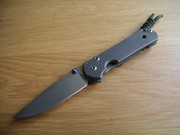
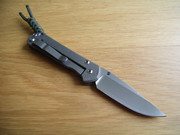

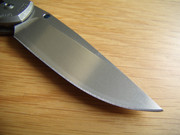
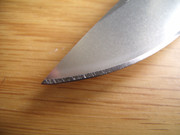
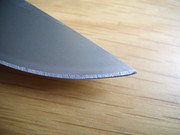
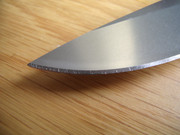
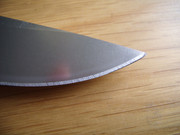
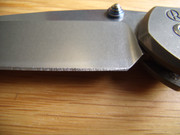
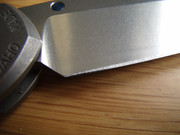
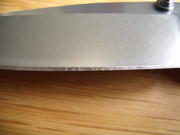

The outcome made him sell the knife for a measly 150 Euro's to owner number two, who sent it to me with the request to tidy things up a bit and give it a bit of a shiny edge.
Below is what the knife looked like when i received it, still with it's very rough and partly unapexed "edge", and with an edge angle of ~40 degrees inclusive at the straight part of the edge, changing into ~45 degrees inclusive from belly to point.












After reprofiling & sharpening on a Paper Wheel with 15 micron diamond compound, then deburring and polishing it a bit with a second Paper Wheel coated with 1.0 micron diamond compound.
The new edge is a bit convex, and measures ~30 degrees inclusive on the straight part of the edge, changing into ~35 degrees inclusive from belly to point.
This to avoid widening the bevels there too much, as this blade is relatively thick behind the edge in that area.
The last picture shows a small facet at the heel which has an entirely different angle, so i could not remove it without making things worse.
Visually it's not perfect yet treetopping sharp, and the owner was happy.
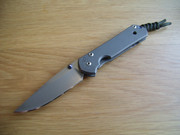
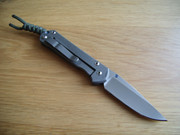
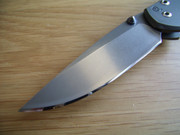
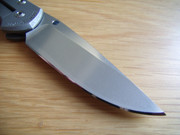
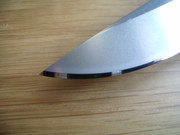

The new edge is a bit convex, and measures ~30 degrees inclusive on the straight part of the edge, changing into ~35 degrees inclusive from belly to point.
This to avoid widening the bevels there too much, as this blade is relatively thick behind the edge in that area.
The last picture shows a small facet at the heel which has an entirely different angle, so i could not remove it without making things worse.
Visually it's not perfect yet treetopping sharp, and the owner was happy.






But you did free hand with the wheels. You weren't using a jigUpdate! I been freehanding a lot lately. I had one Spyderco in s110 v that I couldn't get just right. I hit the paper wheel and boom. Wicked edge. Very sharp and keen. Ive come to like freehanding. But I can't argue with the results. And fast too.
Yes. I marked my wheel with a protractor when I got it. So it's just a matter of hitting the wheel at the right place while holding the blade parallel to the ground. Easy peesy. I can get the same edge off of my dmts and venev stones/plates with some stropping. But the paper wheel is so fast.But you did free hand with the wheels. You weren't using a jig
User LH Sebenza Micarta with it's blade made from Devin Thomas stainless basketweave damascus (AEB-L and 304)
Reprofiled & sharpened the old slightly convex edge with it's apex @ ~40 degrees inclusive into a new slightly convex edge with an apex @ ~30 degrees inclusive on a Paper Wheel with 15 micron diamond compound, then removed the extremely fine burr on a piece of copypaper with a dab of 0.25 micron diamond paste.
The new apex is reverse chest hair whittling sharp and the new point is also quite close to being centered again.
To my functioning eye the bevels look near-mirror like, but the camera sees a bit blotchy scratch pattern due to the different layers in the damascus steel.
Before:
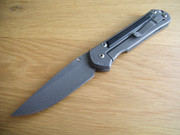
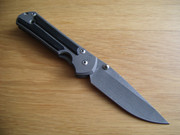
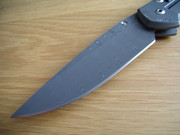
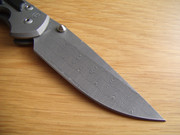
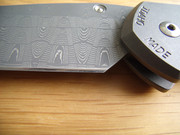
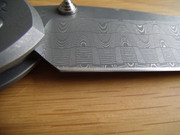
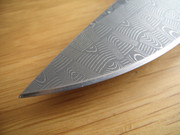
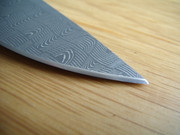
After:

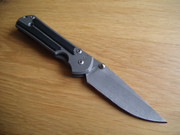
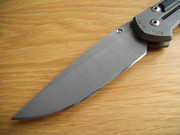
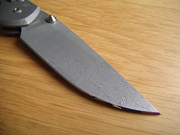
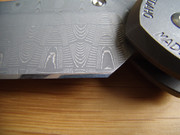
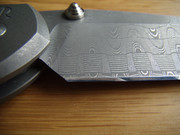
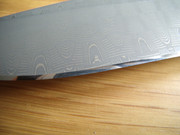
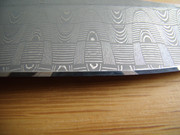

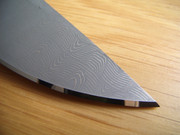
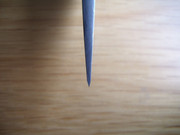
Reprofiled & sharpened the old slightly convex edge with it's apex @ ~40 degrees inclusive into a new slightly convex edge with an apex @ ~30 degrees inclusive on a Paper Wheel with 15 micron diamond compound, then removed the extremely fine burr on a piece of copypaper with a dab of 0.25 micron diamond paste.
The new apex is reverse chest hair whittling sharp and the new point is also quite close to being centered again.
To my functioning eye the bevels look near-mirror like, but the camera sees a bit blotchy scratch pattern due to the different layers in the damascus steel.
Before:








After:











